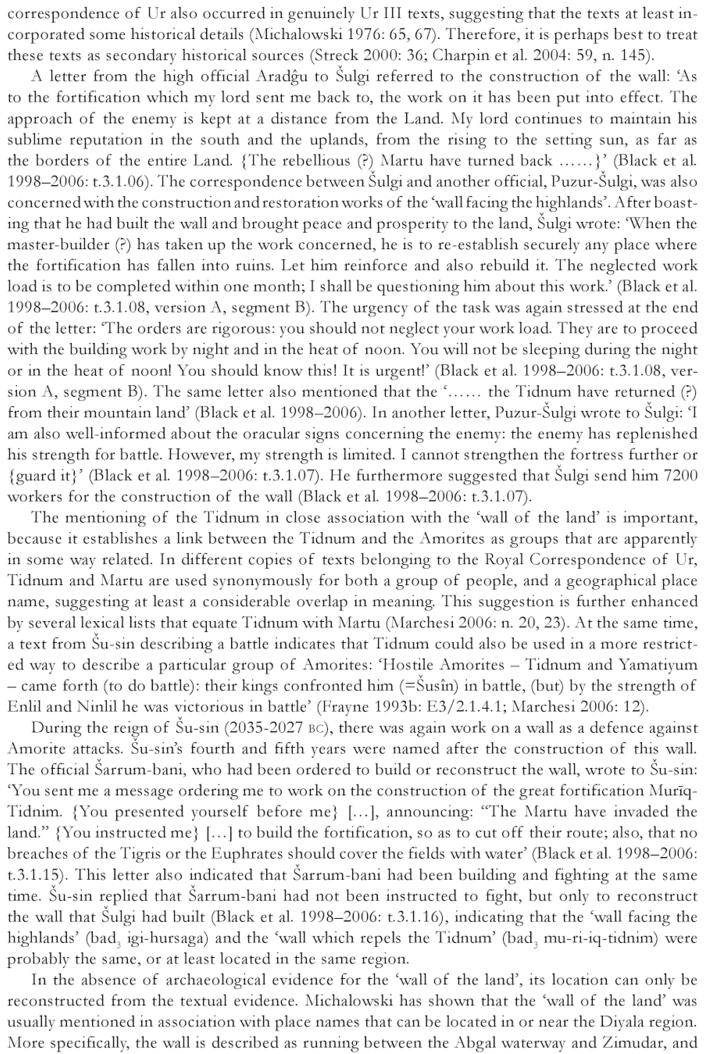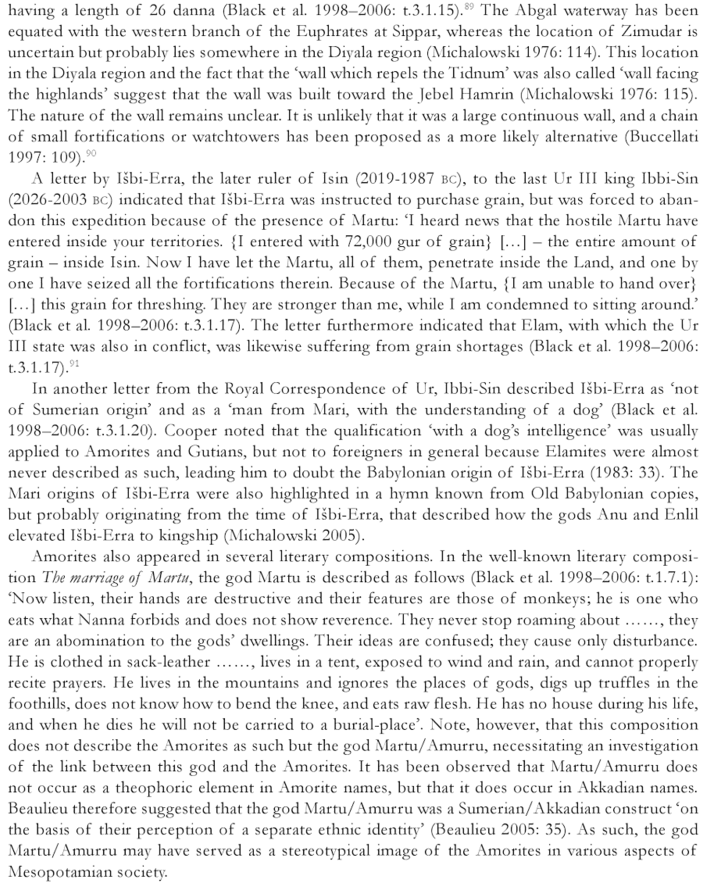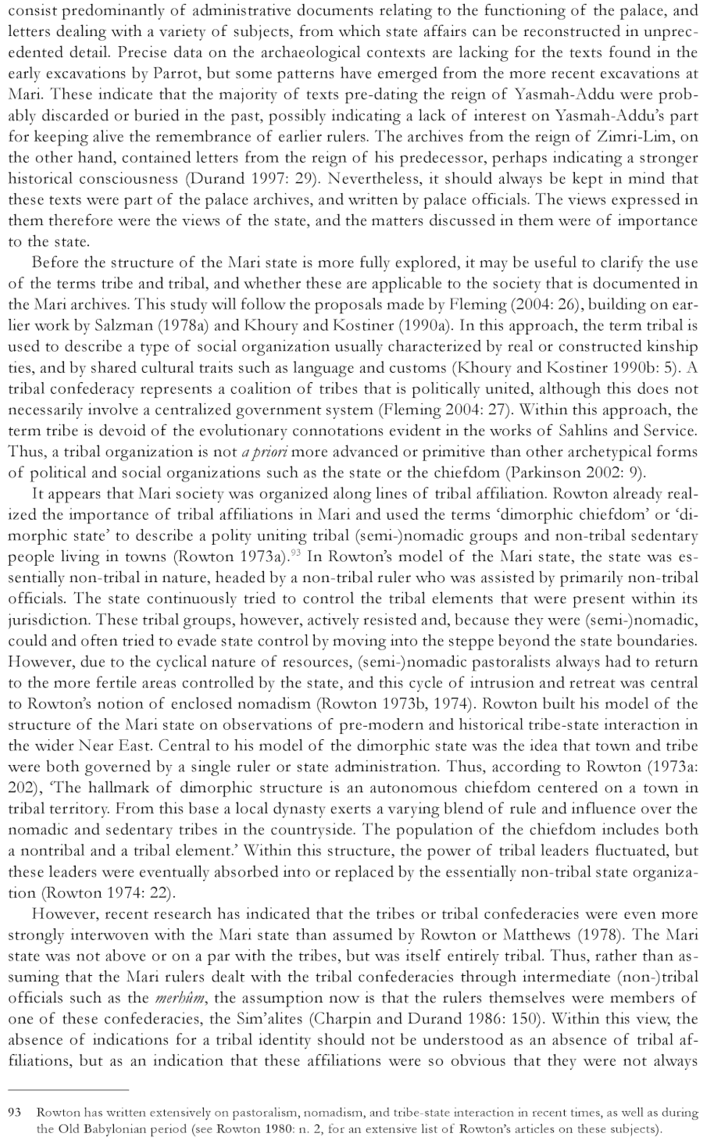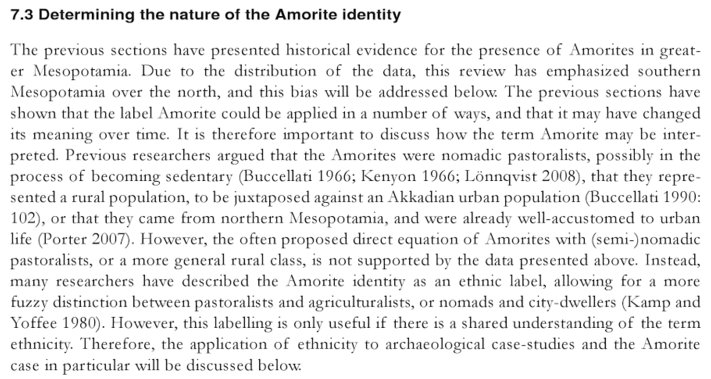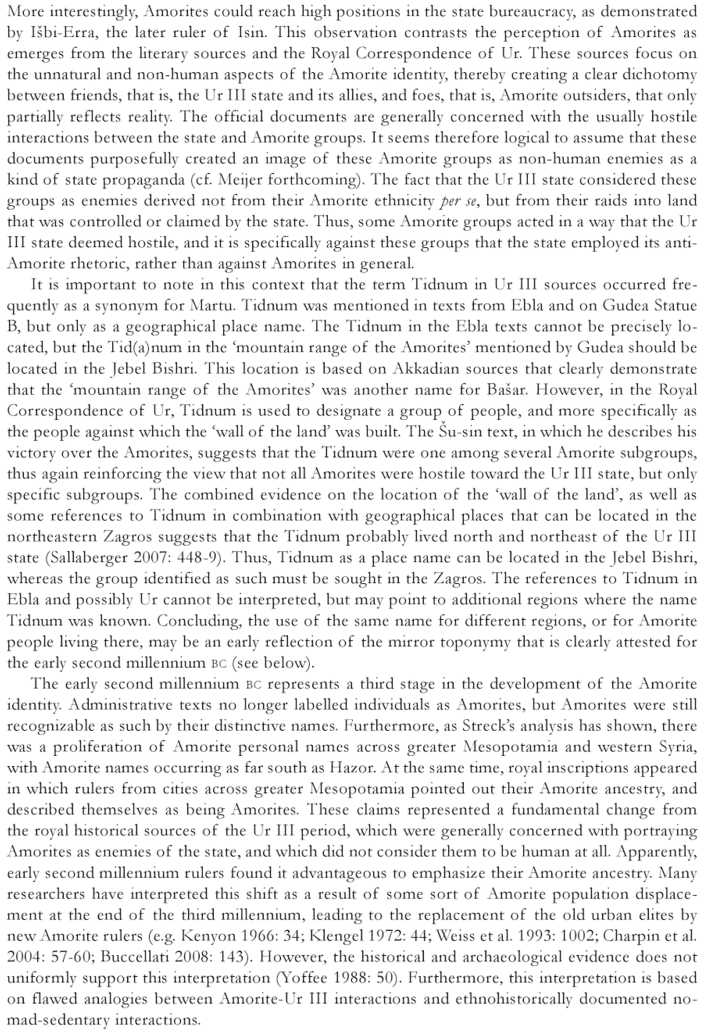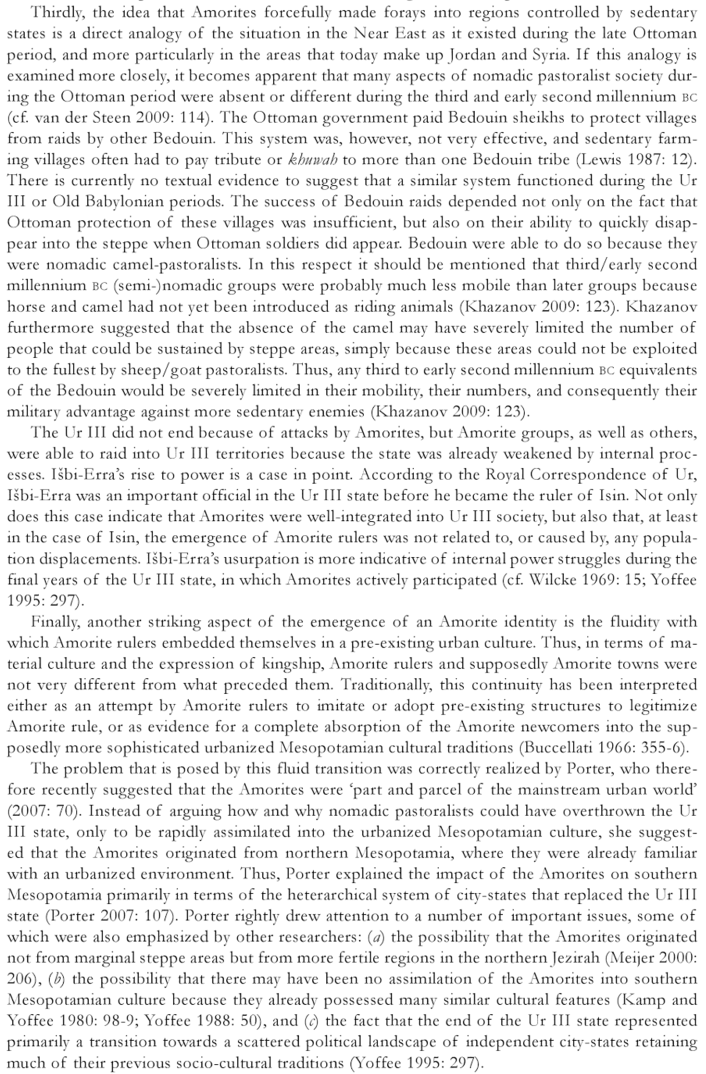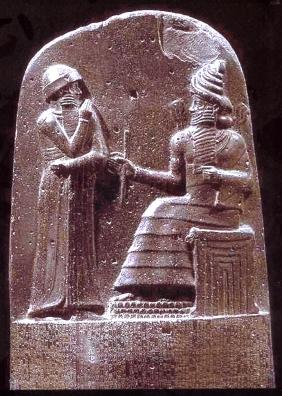|
Other Archaeological Sites / The Neolithic of the Levant (500 Page Book Online)
Amorites (Sumerian MAR.TU; Akkadian Tidnum or Amurrūm;
Amorite Page from A Dictionary of Archaeology --- Edited by Ian Shaw and Robert Jameson (1999)
AMORITES in The Penny Cyclopaedia Volume 1 (1833)
Amorite in Cyclopedia of Biblical, Theological and Ecclesiastical Literature
Amorites in Bridgeway Bible Dictionary(2004)
Amorites in the Perseus Digital Library at Tufts University
The Amorites were members of an ancient Semitic-speaking people who dominated the history of Mesopotamia -- Syria -- Palestine from about 2000 to about 1600 BC. In the oldest cuneiform sources (circa 2400–2000 BC) the Amorites were equated with the West; although their true place of origin was most likely Arabia -- not Syria. They were troublesome nomads and were believed to be one of the causes of the downfall of the 3rd Dynasty of Ur (circa 2112–2004 BC) (3). Note: The word Amorite has two different points of reference --- an earlier Mesopotamian one and a later biblical one --- which seem to have no connection whatsoever except for the name. The reference to "Amorites" in the bible is based on a distant memory of a name that would have a different meaning in the third millennium B.C.E. rather than to the later Hebrews (A).
Pages 119-29 in (1) Challenging Climate Change: Competition and Cooperation Among Pastoralists and 7.2.1 Amorites before the Ur III period: The term Tidnum, which is used nearly synonymously for Amorite during the Ur III period, possibly already occurs in archaic Early Dynastic I texts from Ur but this suggestion cannot be further substantiated at the moment. The first reliable references to people of supposedly Amorite affiliation date to the ED IIIa period and come from texts found in Shuruppak. There are a few names of supposedly Amorite origin despite the fact that the determinant Martu is lacking. However this qualification does appear at this site in combination with personal names (1).
7.4 Conclusion: Amorites were mentioned in historical records from circa 2500 BC onwards with a strong emphasis on the Ur III period as well as the early second millennium BC. This evidence indicates that the perception of Amorites by those who wrote about them changed over time. Whereas the mid-third millennium texts are difficult to assess, the Ur III texts clearly show a discrepancy between the perception of Amorites in literary sources and administrative documents. The literary sources provide a stereotypical view of Amorites as being uncivilized and hostile toward the Ur III state whereas the administrative texts indicate that Amorites were well-integrated into Ur III society. The early-second millennium material shows that Amorites could be found in all levels of society and that many rulers across greater Mesopotamia were proud of their Amorite heritage. The Mari archives furthermore show that Amorite states were not organized on an agriculturalist-pastoralist dichotomy, as has been previously emphasized, but that these states were based on tribal identities that encompassed both economies. This evidence suggests that the incorporation of both the pastoral as well as the agricultural economy may have been the defining aspect of Amorite identity. The most important conclusion must be that the Amorite ethnicity emerged as an identity that can be interpreted as signifying a social network extending over large distances. The spatial distribution of the literary sources points to a strong focus on lower Mesopotamia as well as the Syrian Euphrates and Khabur basins. The Amorite era ended in northern Mesopotamia when both the Amorite-dominated Babylonians and their Amorite rulers were driven from Assyria by an Assyrian-Akkadian governor named Puzur-Sin circa 1740 BC. After six years of civil war a native king named Adasi seized power circa 1735 BC and went on to stabilise Assyria and free it from Amorite influence (See 5 Below). Following the death of Hammurabi (reigned circa 1792 BC to 1750 BC) the short-lived Babylonian Empire began to collapse under his successor Samsu-iluna (1749–1712 BC). His reign was marked by the violent uprisings of areas conquered by his father and the abandonment of several important cities. Native Akkadian speakers threw off Amorite and Babylonian rule in the south of Mesopotamia, creating the Sealand Dynasty the region of ancient Sumer circa 1730 BC. This dynasty was named for the Sealand province in the far south of Mesopotamia --- a swampy region bereft of large settlements which gradually expanded southwards with the silting up of the mouths of the Tigris and Euphrates rivers (ibid). The Amorites clung on in a once-more small and weak Babylon until the Hittite sack of Babylon (circa 1595 BC) which ended the Amorite presence and brought new ethnic groups (particularly the Kassites) to the forefront in southern Mesopotamia. From the 15th century BC onward the term Amurru is usually applied to the region extending north of Canaan as far as Kadesh on the Orontes River in northern Syria (ibid). After their expulsion from Mesopotamia the Amorites of Syria came under the domination of first the Hittites and, from the 14th century BC, the Middle Assyrian Empire (1365–1050). They appear to have been displaced or absorbed by a new wave of semi-nomadic West Semitic-speaking peoples known collectively as the Ahlamu during the Late Bronze Age collapse. The Arameans rose to be the prominent group amongst the Ahlamu and from circa 1200 BC on the Amorites disappeared from the pages of history. From then on the region that they had inhabited became known as Aram ("Aramea") and Eber-Nari (Ibid). (4) The International Standard Bible Encyclopaedia: Volume 1 -- Edited by James Orr (1915) SEE Emori (’ĕ·mō·rî) in Strong's Concordance etcetera (Bible Hub) The name Amorite is used in the Old Testament to denote (1) the inhabitants of Palestine generally (2) the population of the hills as opposed to the plain and (3) a specific people under a king of their own. Thus we hear of them on the west shore of the Dead Sea (Genesis 14:7) --- at Hebron (Genesis 14:13) and Shechem (Genesis 48:22) in Gilead and Bashan (Deuteronomy 3:10) and under Mount Hermon (Deuteronomy 3:8; Deuteronomy 4:48). They are named instead of the Canaanites as the inhabitants of Palestine whom the Israelites were required to exterminate [in this case the word Amorite is used instead of and to symbolize all the Canaanites --- See for instance Judges 6:10]. And I said unto you I am the LORD your God; fear not the gods of the Amorites in whose land ye dwell ... The older population of Judah is called Amorite in Joshua 10 5-6 in conformity with which Ezekiel 16:3 states that Jerusalem had an Amorite father; and the Gibeonites are said to have been "of the remnant of the Amorites" (2 Samuel 21:2). On the other hand in Numbers 13:29 the Amorites are described as dwelling in the mountains like the Hittites and Jebusites of Jerusalem, while the Amalekites or Bedouins lived in the south and the Canaanites on the seacoast and in the valley of the Jordan. Lastly we hear of Sihon "King of the Amorites" who had conquered the northern half of Moab (Numbers 21 21-31; Dt 2 26-35). (2) Who Were the Amorites by Alfred Haldar in Monographs of the Ancient Near East (1971) Abram (Abraham) the Hebrew (Habiru) reckoned Amorite groups as his confederates. Without regard to the date reflected in this tradition we may be justified in concluding that it reveals conditions of times long since passed when there existed friendly relations between the Habiru/Hebrews and the Amorites. It also reveals conditions prevailing during that time when local Amorite centers -- not to say kingdoms -- existed in Palestine. This is by no means astonishing for there is also in late tradition a clear consciousness of the fact that the Amorites were an important ethnic group merging into the Israelite people once upon a time
Ezekiel 16:1 Again the word of the LORD came unto me saying: 16:2 Son of man cause Jerusalem to know her abominations
16:3 And say "Thus saith the Lord GOD unto Jerusalem; Thy birth and thy nativity
is of the land of Canaan; This of course is implying that the Hebrews were defiled in the process of conquering -- assimilating -- propagating (and thus becoming what were called Israelites) with these Canaanite idol worshippers and their abominations in the sight of the Lord. In Genesis 10:15-16 the "Amorite" is said to be a son of Canaan
10:15 And Canaan begat Sidon his firstborn and Heth 10:16 And the Jebusite and the AMORITE and the Girgasite In Genesis 10:6 of the same chapter Canaan is said to be the youngest son of Ham ...
10:6 And the sons of Ham; Cush and Mizraim and Phut and Canaan
According to Old Testament tradition there were a number of local Amorite Kingdoms in Palestine and Syria during the second millenium BC. In some passages of the Bible there is a clear distinction between Amorites and Canaanites; in others the two terms would seem to overlap. But the usages of the two terms are not consistent nor the general view of the character of the Amorites. The main groups of the Semites are the following ... East Semites: Akkadians / Assyrians / Babylonians West Semites: Amorites / Canaanites / Hebrews / Aramaeans / Phoenicians South Semites: North Arabs / South Arabs / Ethiopians Since modern anthropological research has revealed the fact that racial distinctions are hardly possible in prehistoric and early historic times the various semitic branches are distinguished solely by their languages. It was only after the "Amorite" language had been recognized that the discussion of Amorite history began
(1) Challenging Climate Change: Competition and Cooperation Among Pastoralists and Agriculturalists in Northern Mesopotamia (circa 3000-1600 BC) by Arne Wossink (2009)
(2) Who Were the Amorites by Alfred Haldar in Monographs of the Ancient Near East (1971)
(3) Amorite --- © 2018 Encyclopædia Britannica
(4) The International Standard Bible Encyclopaedia: Volume 1 --- Edited by James Orr (1915)
(5) Amorites --- Amorite Language --- Babylonia --- Sealand Dynasty in WikiPedia
(A) Peoples of the Bible: The Legend of the Amorites --- Haaretz Newspaper in Israel Online
|



